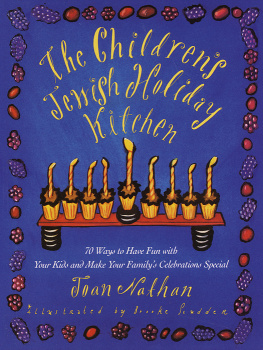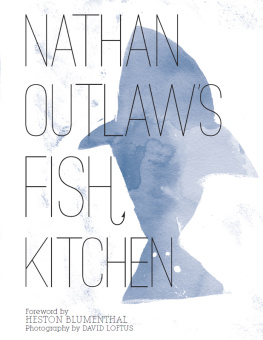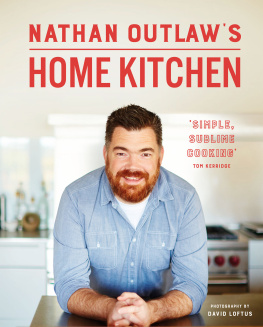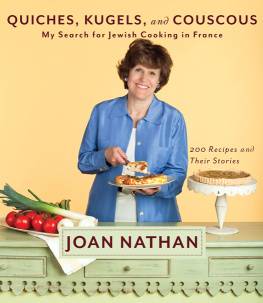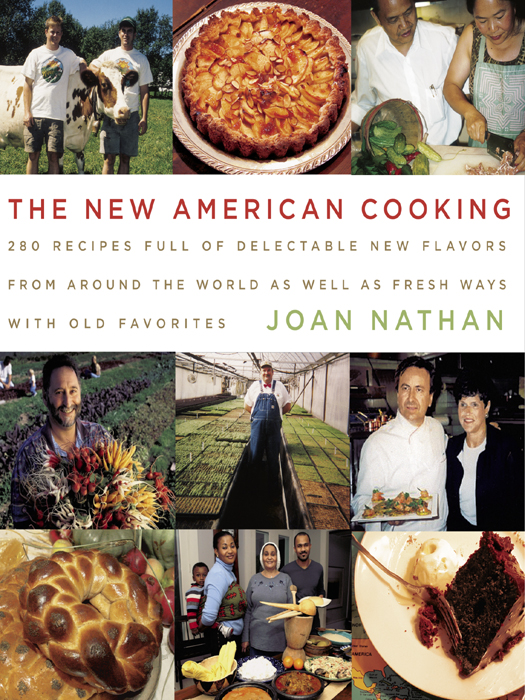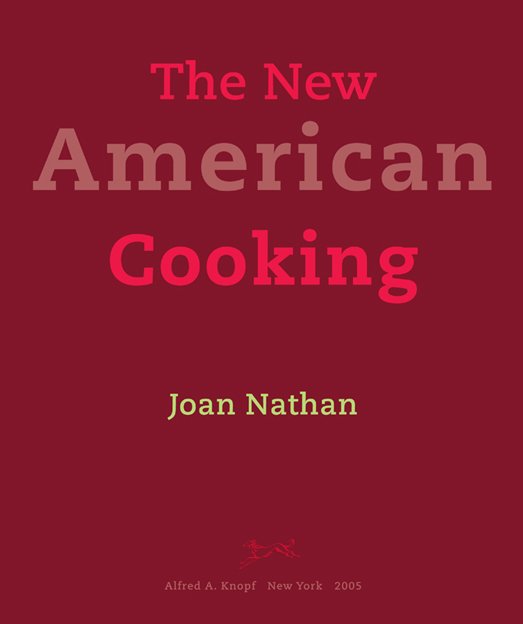Also by Joan Nathan
Joan Nathans Jewish Holiday Cookbook
The Foods of Israel Today
Jewish Cooking in America, Expanded Edition
The Jewish Holiday Baker
Jewish Cooking in America
The Jewish Holiday Kitchen
The Childrens Jewish Holiday Kitchen
An American Folklife Cookbook
The Flavor of Jerusalem (with Judy Stacey Goldman)
THIS IS A BORZOI BOOK
PUBLISHED BY ALFRED A. KNOPF
Copyright 2005 by Joan Nathan
All rights reserved. Published in the United States by Alfred A. Knopf, New York, and in Canada by Random House of Canada Limited, Toronto.
www.aaknopf.com
Permission to reprint previously published material may be found following the index.
Library of Congress Cataloging-in-Publication Data
Nathan, Joan.
The new American cooking / by Joan Nathan.1st ed.
p. cm.
Includes bibliographical references and index.
eISBN: 978-0-307-53887-1
1.Cookery, American. I. Title.
TX715.N275 2005
641.5973dc22 2004042328
v3.1
Jacket design by Carol Devine Carson and Abby Weintraub
In memory of chef Jean-Louis Palladin,
who, through his unbounded enthusiasm for American foods and flavors,
inspired us to look at our own cooking in a new light.
Born in southwest France, May 7, 1946
Died in Washington, D.C., November 25, 2001
Contents
Introduction
I n the summer of 2001, the Smithsonian National Museum of American History added Julia Childs kitchen to its permanent collection, placing her in the company of American icons like Thomas Edison and Muhammad Ali. At the opening reception, guests were served a stunning menu of American food, including seared bison filet with pepper relish and pappadam, a purple Cherokee tomato tartlet with goat cheese and herbs, and a local organic sweet tomato tartlet with basil and ricotta gelato. These were not the kind of classic French dishes that Julia introduced to the American public, I thought to myself. Instead, the meal was a wonderful mosaic of healthy, natural, spicy foods from a vast variety of cultures, the kind of food that Americans have been embracing more and more heartily in recent years.
I think that experience really set the course for this new book, The New American Cooking. I felt compelled to discover how and why the transformation in American food came about, to seek out the people, both known and unknown, who were responsible for the new openness in our tastes. Indeed, thats the best definition I have of American food todaya new receptivity to exploring the old and the new and melding the two. Until now I have written mostly about Jewish food, a tale of amazing evolution and adaptation both in this country and in Israel. But I have always been interested in the larger picture of how other ethnicities have affected America and the way we eat. With myriad immigrant groups, we are living now in one of the most exciting periods in the history of American food. For those who cook at home, there is an almost endless array of ingredients and spices from which to choose. Those who eat out in ethnic and upscale restaurants have a wide variety of delicious dishes that were unavailable a decade ago. According to the Library of Congress, in the past thirty years there have been more than three thousand American cookbooks published, more than the number published in the previous two centuries combined. The worlds food is now literally at our fingertips.
When I told my children what I had in mind, they said a new American book had to include Cheez Whiz and McDonalds. No, I insisted. We all know about the growing power of fast-food chains and agribusiness, of people not eating together as a family, of processed microwave meals and the couch-potato syndrome. During a recent visit to the Missouri countryside, I stopped at a mega supermarket in a small town surrounded by farmland. In the midst of strawberry fields and streams overflowing with trout, I found myself in a market where everything was plastic and processed. I often think about the author Barbara Kingsolvers comment: Many adults, Im convinced, believe that food comes from grocery stores.
But thats the downside. What I wanted to explore is the positive aspect of American food today. Over the past few years, I have crisscrossed this country, from California to Alaska, from Washington, D.C., to Puerto Rico. I watched a young man handcraft cheese in the Northeast Kingdom of Vermont. At dawn I accompanied chef Alan Wong and his students to the Honolulu fish auction. I gathered wild rice with Ojibwe Indians in northern Minnesota, I ate a Japanese-inspired omelet with a musician in the heart of the Ozarks, and I ate Sunday dinner with a family of Cambodian farmers in Lowell, Massachusetts. I have explored home kitchens, farms, processing plants, and restaurants, seeking out people who have helped to make American food what it is today. It is these people, with their stories and their recipes, who fill the pages of this book.
The year 1965, when I graduated from the University of Michigan, was a time of momentous change both for me personally and for the country. After my junior year studying abroad in Paris, where my taste buds were opened, I was ready for Julia Childs Mastering the Art of French Cooking and Craig Claibornes New York Times Cookbook, both of which had been published in 1961. Other graduates of that same period would take cooking to the next levelchefs like Californias Alice Waters, who used local organic crops, artisanal cheeses, free-range chicken, and grass-fed beef in her Berkeley haunt, Chez Panisse.
When in college, none of us would have guessed that the March on Washington or the antiwar movement would affect the way we eat. But they did. The Voting Rights Act of 1965, which gave African Americans the right to vote, also enhanced the dignity of black culture and cuisine in the eyes of white Americans. Meanwhile, the antiwar movement influenced a new generation of eaters, who began to demand what the sociologist Warren Belasco has called counter cuisinean attempt to return to a natural, more simple way of life. In those years, health food consciousness was growing among fringe groups, who started eating new and weird foods in their vegetarian diet such as soy milk, brown rice, and yogurt. All these, and many others like them, are considered staples today.
Until 1965, immigrants to the United States came mainly from European countries like France, Germany, Hungary, Italy, Poland, and the Soviet Union. But the Johnson administration, widening its response to the civil rights movement and the Vietnam War, passed the 1965 Immigration Act, eliminating the rigid immigration quota system of the 1952 McCarran-Walter Act. As a result, there was a large influx of new immigrants, many of them from Latin America and others from countries like Vietnam, Thailand, Afghanistan, and Lebanoncountries not even mentioned in the 1970 census. All brought with them new foods and new flavors. As The New Yorker writer Calvin Trillin aptly put it, I have to say that some serious eaters think of the Immigration Act of 1965 as their very own Emancipation Proclamation.
In the Iron District of Newark, New Jersey, once primarily home to Portuguese immigrants, the demographics are changingwhen I visited the seventy-five-year-old Popular Fish Market there, lines of Portuguese and now also Spanish and Brazilian immigrants had their pick of eel, clams, corvine, frozen sardines, lobsters, and baccalhau (dried cod). In New York City, a subway ride takes you to a Chinatown that now includes a varied Asian population with their different foodways. Pedestrians in Manhattan nosh on vegetarian soul food, Chinese-Mexican food, and Vietnamese or Puerto Rican bagels. Cross the Hudson River, and you enter a Japanese neighborhood with a mega supermarket devoted to Japanese food. Cross the East River, and just whiff the pungent Indian spices as you emerge from the subway in Jackson Heights.


